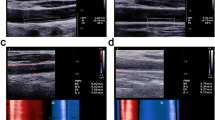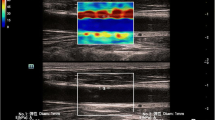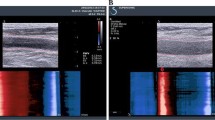Abstract
Purpose
The purpose of this study was to compare the carotid artery wall elasticity between patients with uremia and controls using echo tracking (ET).
Methods
Ninety-three patients with uremia and 35 control subjects (Group A) were enrolled in this study. In the ET mode, the carotid artery elasticity parameters including stiffness index (β), pressure–strain elasticity modulus (EP), arterial compliance (AC), and one-point pulse wave velocity (PWVβ) were measured, and carotid intima–media thickness (IMT) was measured with B-mode ultrasonography. The patients were classified into three groups: Group B (normal IMT), Group C (thickened IMT), and Group D (one single atheroma plaque).
Results
β, EP, and PWVβ were significantly higher in Group B, C, and D (especially in group D) than those of the control group (P < 0.05), and there were significant differences between Group A and Group B, while AC was lower than in controls, but there were no statistically significant differences among the four groups.
Conclusions
ET is a noninvasive method that can demonstrate a loss in carotid artery elasticity in uremia patients with normal IMT.


Similar content being viewed by others
References
Shafiee MA, Akbarian F, Memon KK, et al. Dermatologic manifestations in end-stage renal disease. Iran J Kidney Dis. 2015;9:339–53.
Ossareh S, Alaei A, Saedi D. Carotid intima–media thickness in maintenance hemodialysis patients: role of cardiovascular risk factor. Iran J Kidney Dis. 2011;5:169–74.
Nassiri AA, Hakemi MS, Asadzadeh R, et al. Differences in cardiovascular disease risk factors associated with maximum and mean carotid intima–media thickness among hemodialysis patients. Iran J Kidney Dis. 2012;6:203–8.
Vaziri ND. Causes of dysregulation of lipid metabolism in chronic renal failure. Semin Dial. 2009;22:644–51.
Insull W Jr. The pathology of atherosclerosis: plaque development and plaque responses to medical treatment. Am J Med. 2009;122:S3–14.
Moshkani FM. Carotid intima–media thickness as a marker of atherosclerosis in hemodialysis patients. Iran J Kidney Dis. 2012;6:161–2.
Matthew RA, Christopher WM, Jason LJ, et al. Genetic inactivation of IL-1 signaling enhances atherosclerotic plaque instability and reduces outward vessel remodeling in advanced atherosclerosis in mice. J Clin Investig. 2012;122:70–9.
Esper RJ, Nordaby RA, Vilarino JO, et al. The endothelial dysfunction. Cardiovasc Diabetol. 2006;23:4–9.
Anderson JL, Halperin JL, Albert NM, et al. Management of patients with peripheral artery disease: a report of the American College of Cardiology Foundation/American Heart Association Task Force on Practice Guidelines. Circulation. 2013;127:1425–43.
Lehmann ED, Gosling RG, Fatemi-Langroudi B, et al. Non-invasive Doppler ultrasound technique for the in vivo assessment of aortic compliance. J Biomed Eng. 1992;14:250–6.
Tanaka M, Sugawara M, Ogasawara Y, et al. Intermittent, moderate-intensity aerobic exercise for only eight weeks reduces arterial stiffness: evaluation by measurement of stiffness parameter and pressure–strain elastic modulus by use of ultrasonic echo tracking. J Med Ultrason. 2013;40:119–24.
Qin YQ, Chen AH, Tang XM. Echo-tracking technology for evaluating the impact of blood pressure on vascular endothelial function. Nan Fang Yi Ke Da Xue Xue Bao. 2012;32:396–9.
Zhou L, Beach KW, Liang HD, et al. Noninvasive measurement of local arterial pulse wave velocity in humans by ultrasound. J Med Eng Technol. 2011;35:362–9.
Stompór T, Rajzer M, Pasowicz M, et al. Coronary artery calcification, common carotid artery intima–media thickness and aortic pulse wave velocity in patients on peritoneal dialysis. Int J Artif Organs. 2006;29:736–44.
Ticulescu CR, Vriz O, Sparacino L, et al. Incremental value of arterial stiffness over traditional risk factors in predicting subclinical cardiovascular remodeling in patients with moderate chronic renal failure. Angiology. 2011;62:662–8.
Mitsumura H, Sakuta K, Bono K, et al. Stiffness parameter β of cardioembolism measured by carotid ultrasound was lower than other stroke subtypes. J Stroke Cerebrovasc Dis. 2014;23:1391–5.
Zhang P, Guo R, Li Z, et al. Effect of smoking on common carotid artery wall elasticity evaluated by echo tracking technique. Ultrasound Med Biol. 2014;40:643–9.
Lene B, Lutgarde T, Thomas EJ, et al. Ambulatory arterial stiffness index in chronic kidney disease stage 2–5. Reproducibility and relationship with pulse wave parameters and kidney function. Scand J Clin Lab Investig. 2012;72:304–12.
Wimmer NJ, Townsend RR, Joffe MM, et al. Correlation between pulse wave velocity and other measures of arterial stiffness in chronic kidney disease. Clin Nephrol. 2007;68:133–43.
Author information
Authors and Affiliations
Contributions
DW and HL contributed equally to this work. HL: study concepts and design/manuscript preparation. DW: clinical studies/manuscript editing. GC: experimental studies/data analysis. YS: guarantor of integrity of the entire study.
Corresponding author
Ethics declarations
Ethical statements
Informed consent to the protocol was obtained from all patients and control subjects. The study was approved by our institutional ethics committee for human research.
Conflict of interest
There are no financial or other relations that could lead to a conflict of interest.
About this article
Cite this article
Liang, H., Wang, D., Che, G. et al. Evaluation of carotid artery elasticity in patients with uremia by echo tracking. J Med Ultrasonics 45, 591–596 (2018). https://doi.org/10.1007/s10396-018-0868-z
Received:
Accepted:
Published:
Issue Date:
DOI: https://doi.org/10.1007/s10396-018-0868-z




